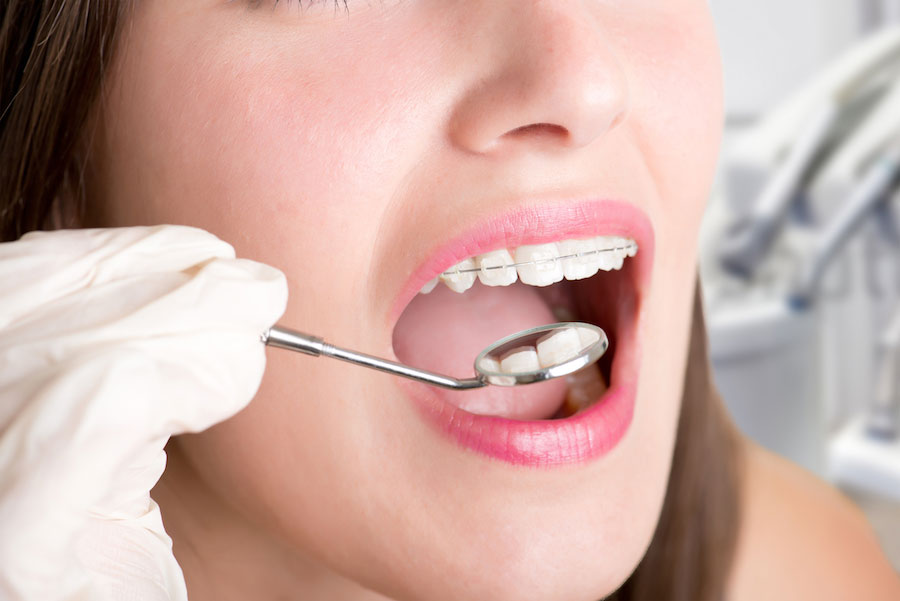The main goal when using orthodontic treatment is to realign the teeth and provide a beautiful smile.
The purpose of the treatment is to use the jaw space properly and it is sometimes necessary to remove teeth so that others can push in the right direction.
One in two children in Europe needs orthodontic treatment. Orthodontic appliances are more effective in children and it is recommended to start treatment between the ages of 10 and 14, as the head and mouth are still growing and the teeth will straighten more easily. However, many adults also start wearing them to correct the alignment of their teeth.
On average, braces should be worn between 18 and 30 months. The orthodontist will need to tighten your braces every two months or more. For this reason, patients must be prepared to travel several times for follow-up care.
There are different types of devices:
• The removable device is used mainly for jaw shifts. It is worn at the beginning for a few hours during the day and then all night long.
• The multi-braces device is used to rectify the position of the teeth. The braces are glued to the teeth and must be worn day and night.
Duration of hospital stay
Between 1 and 4 days.
Several trips are to be expected.
Average length of stay
About 10 trips.
The patient must consult every two months.

Every year, nearly 11 million patients go abroad in search of medical care. At MEDICAIM, we provide our patients with access to the best hospitals and doctors around the world. Contact us to learn more about your treatment options.
Ask for your free quote abroad
Start your medical stay by requesting a quote. Our customer service department will help you find the clinic that best suits your needs and get you a quote.
A first consultation is necessary for the specialist to look at the teeth and possible problems.
The orthodontist makes impressions of the upper and lower jaws. To confirm the diagnosis, he/she needs panoramic X-rays and profiles.
Panoramic radio is really essential to consider all problems. Otherwise no other examination will be able to see them. It provides a good overview and allows you to see the direction of the teeth as they grow. It also shows that there may be supernumerary teeth or missing teeth.
The profile radio helps to confirm the diagnosis.
Using the impressions of the mouth, the dentist will be able to establish an orthodontic check-up.
He/she will also explain the treatment he/she plans and the equipment.
First step:
• The orthodontist installs a retractor, usually made of plastic, to open the lips and thus have a good visibility of the teeth.
• The first step is to clean the teeth so that the braces are fixed on clean teeth. The teeth are very dry, so a product is applied and rinsed a few seconds later.
• A gel is then applied to the future locations of the braces, this gel makes the tooth surface a little rougher. This rough surface will allow the glue that holds the braces to cling better.
Installation of the braces:
• The installation of the braces has arrived: special glue, or resin, is applied between the tooth and the metal or ceramic braces. Each ring is associated with a particular tooth. With the brace in place, the orthodontist removes the excess glue.
• In order to permanently fix each brace to each tooth, a high intensity blue light is used to harden the resin. A few seconds are enough for each tooth. The braces are then permanently placed and are supposed not to move until the end of the treatment.
Thread placement:
• The installation of The device is nearing completion. The orthodontist removes The retractor that allowed him/her to see all The teeth. then comes The possibility to clean your mouth and feel The braces under your lips for The first time.
• All that is missing is to connect all the braces by means of a thread. The thread is placed in the center of each brace and is fixed with small plastic rings. These rings, called ligatures, can give colour to the braces.
Materials:
The braces are made of stainless steel or stainless steel with titanium. Nowadays, there is a strong demand for more aesthetic braces, and many dentists offer ceramic (usually made from a strong composite) or transparent plastic braces such as Invisalign.

When wearing braces, you must have impeccable oral hygiene. Food tends to settle between the braces, so it is essential to brush your teeth after each meal.
The braces apply permanent pressure to the teeth, making them feel uncomfortable. This discomfort is more pronounced after an appointment when the device has been tightened.
It is important to follow the orthodontist's instructions.
Any additional questions? Ask your MEDICAIM doctor about it: careteam@medicaim.com
Some needs and conditions are more complex than others. In case of doubt, please send us additional information to establish a customized quote.
Ask for a quoteCertains besoins et pathologies sont plus complexes que d’autres. En cas de doute, faîtes-nous parvenir des informations complémentaires pour établir un devis sur-mesure.
Demander un devisEntrust us with your medical file and it will be examined by a specialist doctor. The goal?
Allow you to evaluate all your treatment options.